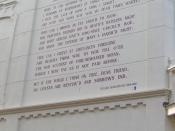Analysis of sonnet 73: "That time of year thou mayst in me behold".
In this sonnet Shakespeare expresses thoughts of his own mortality and the mental anguish associated with moving further from youth and closer to death. He describes times' destruction of great monuments juxtaposed with the effects of age on human beings. This is a convention seen in many Shakespearean sonnets.
Shakespeare speaks to a friend; he speaks with authority and learnedness, which indicates he is older than his friend. I feel he is trying to teach what he deems to be a valuable lesson in life. His mood is sombre and his language expressive. The poet is preparing his young friend, not for approaching the literal death of his body, but the metaphorical death of his youth and passion. The poet's deep insecurities swell irrepressibly as he concludes that the young man is now focused only on the signs of his ageing, as the poet surely is himself, this is illustrated by the linear development of the three quatrains.
The first two quatrains establish what Shakespeare perceives the young man now sees as he looks at the poet; those yellow leaves and bare boughs, and the faint afterglow of the fading sun. The third quatrain reveals that Shakespeare is not speaking of his impending physical death, but the death of his youth, and subsequently, his relationship with the young man. The poet tries to impart his wisdom of times' wrath and more specifically, the grim truth that time will one day have the same impact on the young man.
This sonnet has a flowing iambic pentameter and meter which is traditional of English sonnets. It also adheres to a strict English rhyme pattern typical of traditional English sonnets. The punctuation and enjambement are essential in this...


